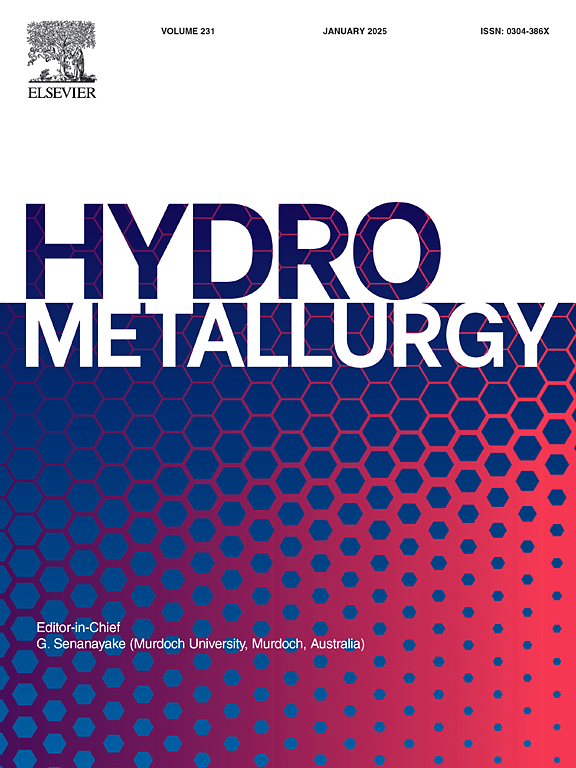铜、金和铀在氯化物溶液中的联合浸出。II.精矿沥滤试验
IF 4.8
2区 材料科学
Q1 METALLURGY & METALLURGICAL ENGINEERING
引用次数: 0
摘要
这项从浮选精矿中同时萃取铜、金和铀的研究旨在确定堆浸工艺的适用条件,该工艺可在一个步骤中回收所有三种金属(如果有银)。本研究获得的结果证实了第一部分(Nicol 等人,2024 年)获得的结果,即在存在氯酸根离子的酸性氯化物溶液中,可以提高从两种不同来源的浮选精矿中萃取黄铜矿的速率。氯酸盐浸出过程中溶液电位的测量结果与之前获得的结果相似,并证实氯酸盐-氯化物反应生成的氯是活性氧化剂。后者通过铁(II)与氯酸盐的反应重新生成。金的溶解需要较高的电位,只有在高浓度氯化物溶液中电位接近 1.0 V 时,金才会被浸出。对金在存在硫化离子的氯化物溶液中的行为进行的电化学研究表明,钝化可能是在浸出液中加入氯酸盐之前,即在产生足够浓度的氯之前,金表面在低电位时形成一层 Au2S 的结果。当电位超过约 0.95 V 时,Au2S 不稳定,会被氧化成 AuCl2- 和元素硫,从而消除钝化。本文章由计算机程序翻译,如有差异,请以英文原文为准。
The combined leaching of copper, gold and uranium in chloride solutions. II. Concentrate leach tests
This study of the simultaneous leaching of copper, gold and uranium from a flotation concentrate is aimed at establishing the conditions that could be applied in a possible heap leach process that would recover all three metals (plus silver, if present) in a single step. The results obtained in this study confirm the results obtained in Part I (Nicol et al., 2024) that enhanced rates for leaching of chalcopyrite from flotation concentrates from two different sources can be obtained in acidic chloride solutions in the presence of chlorate ions. The measurements of the solution potentials during leaching with chlorate are similar to those obtained previously and confirm that chlorine generated by the chlorate-chloride reaction is the active oxidant.
Uranium is dissolved even in the absence of chlorate by iron(III) as the oxidant. The latter is re-generated by reaction of iron(II) with chlorate. The dissolution of gold requires higher potentials, and it is only leached when the potential approaches 1.0 V in concentrated chloride solutions. At low chloride concentrations (1 M), gold is not dissolved because of apparent passivation.
An electrochemical study of the behaviour of gold in chloride solutions in the presence of sulfide ions has shown that the passivation is probably the result of the formation of a layer of Au2S on the gold surface at low potentials before the addition of chlorate to the leach solutions i.e., before the generation of sufficient chlorine concentrations. At potentials above about 0.95 V Au2S is unstable being oxidised to AuCl2− and elemental sulfur thereby eliminating passivation.
求助全文
通过发布文献求助,成功后即可免费获取论文全文。
去求助
来源期刊

Hydrometallurgy
工程技术-冶金工程
CiteScore
9.50
自引率
6.40%
发文量
144
审稿时长
3.4 months
期刊介绍:
Hydrometallurgy aims to compile studies on novel processes, process design, chemistry, modelling, control, economics and interfaces between unit operations, and to provide a forum for discussions on case histories and operational difficulties.
Topics covered include: leaching of metal values by chemical reagents or bacterial action at ambient or elevated pressures and temperatures; separation of solids from leach liquors; removal of impurities and recovery of metal values by precipitation, ion exchange, solvent extraction, gaseous reduction, cementation, electro-winning and electro-refining; pre-treatment of ores by roasting or chemical treatments such as halogenation or reduction; recycling of reagents and treatment of effluents.
 求助内容:
求助内容: 应助结果提醒方式:
应助结果提醒方式:


